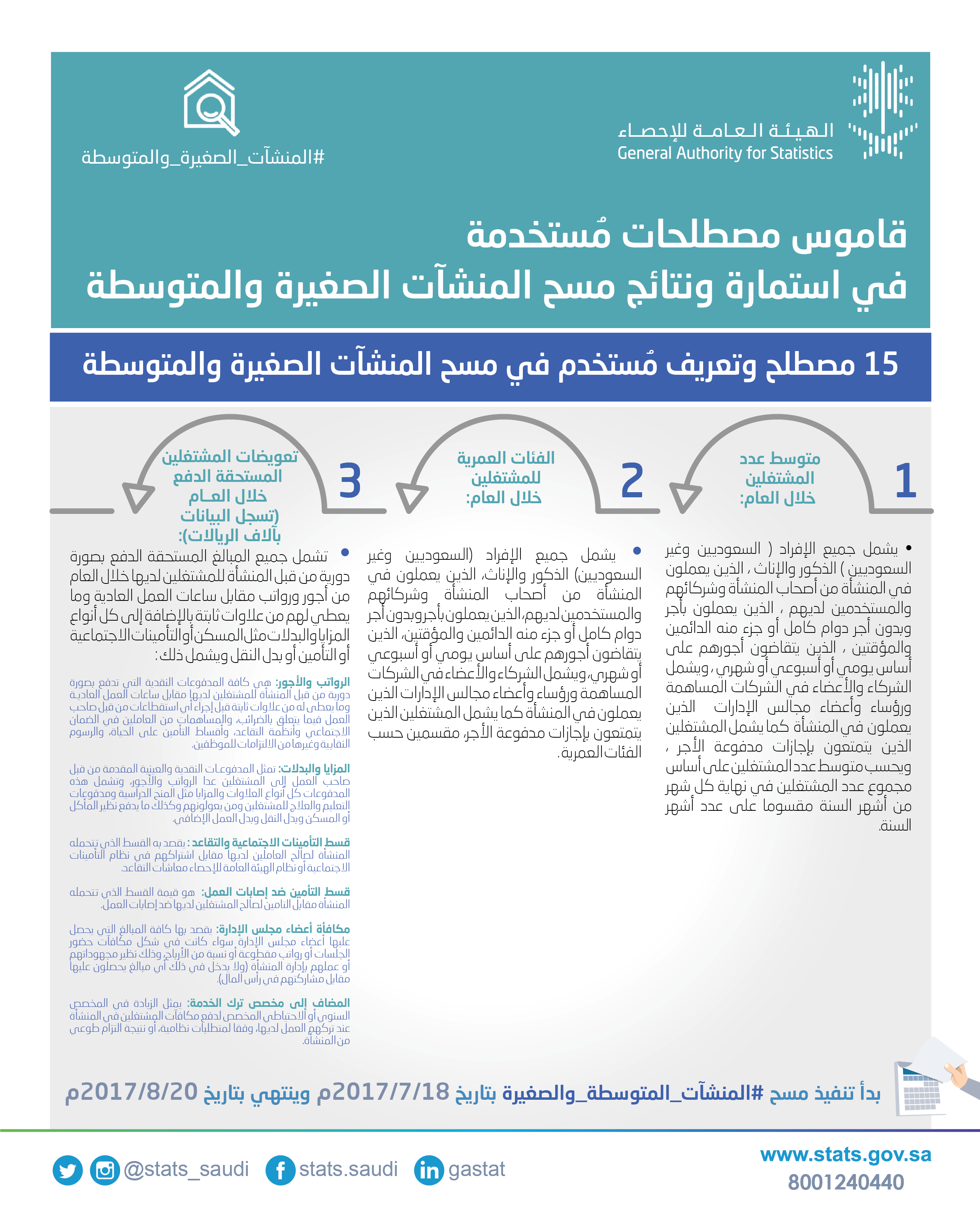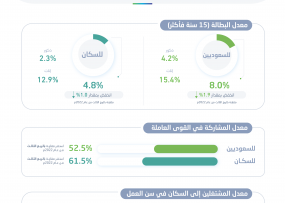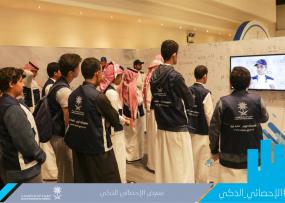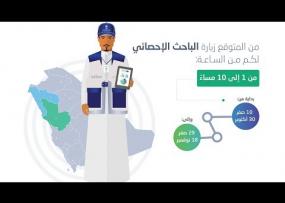Last update 12 / 09 / 2017
Terms and Definitions used in Small and Medium-Sized Establishments Survey

Average number of workers in year:
It includes all individuals (Saudis and non-Saudis) males and females, who work at the establishment. It also include establishment owners, partners, employees who work for a wage, volunteers, those who work full time or part time, temporary workers, and those who are paid on a daily, weekly, or monthly basis. It also includes partners and members at shareholding companies, governing council heads and members who work at the establishment, in addition to workers who have paid leaves. The average number of workers is calculated by dividing the number of workers at the end of each month of the year on the number of the months of the year.
Workers age groups during the year:
It includes all individuals (Saudis and non-Saudis) males and females, who work at the establishment. It also include establishment owners, their partners, employees who work for a wage, volunteers, those who work full time or part time, temporary workers, and those who are paid on a daily, weekly, or monthly basis. It also includes partners and members at shareholding companies, governing council heads and members who work at the establishment, in addition to workers who have paid leaves, classified according to their age groups.
Employees' payable remuneration in year (Thousand Riyals):
The due regular amounts paid by the establishment to its workers throughout the year, such as wages and salaries payable in consideration of the normal working hours, fixed bonuses together with all benefits and allowances such as accommodation, social insurance or transport allowances..... etc., including:
Wages and salaries:
They are all cash payments, which are paid regularly by the establishment to employees in return for their normal work hours as well as fixed premiums before making any cuts by the employer in terms of taxes and contributions by workers in the social insurance, pension systems, life insurance installments, union fees and other obligations of employees
Benefits and Allowances:
Cash and in-kind payments that are made by the employer to the workers except for salaries and wages. Such payments include all sorts of bonuses and benefits, such as scholarships, education and medicine payments for the worker or his /her dependents, food and housing allowances, transport allowances and overtime ... etc.
Social Insurance and Pension Premium:
It refers to the installment that the establishment undertakes for the favor of the establishment's workers in return for their subscription in social insurance system or GASTAT retirement pension system.
Workplace Personal Injury Insurance Premium:
It is the installment borne by the establishment in return for insurance for employees against work injuries
Board Member Remuneration:
It means all amounts that board members get whether in the form of rewards for attending sessions, paid salaries or a percentage of profits in return for their efforts or for managing the establishment (This does not include any amounts they get in return for their participation in the capital).
The added to the severance provision:
It represents the increase in the annual allocation or the reserve allocated for paying rewards of employees of the establishment when they leave work according to system requirements or as a result of a voluntary commitment by the establishment
Goods supplies and services during the year (data are recorded in thousands of Saudi riyals):
Goods supplies and services which cover all payments made by the establishment to practice an economic activity, whether purchased in the same year or taken from stocks purchased in previous years, including:
A-Commodity requirements:
The values of all local and imported goods supplies used by the establishment either in productive goods installation (such as raw materials), or the goods required for their production. It also includes the values of stationery, spare parts, fuel, oils, electricity and water consumption costs ... etc., or any other goods supplies with mentioning the types of such goods for necessity.
B-Service requirements:
The values of all service requirements that the establishment uses including post office and telephone costs, training and secondment costs, travel costs, machines and equipment rent costs, premises and non-agricultural lands rent costs, and what the establishment pay for legal consultations or for services provided by others ... etc., or any other service requirements with mentioning the types of such services for necessity.
The most important service requirements:
Maintenance services:
All the costs that the establishment pay for the maintenance of all assets such as buildings, machines, furniture, equipment, and all types of fixed assets.
Banking service charges:
Bank expenses such as commissions, accounts opening costs, bills and checks collection, and money transfer ... etc. This does not include paid interests.
Transformational expenditures (data are recorded in thousands of Saudi riyals):
Transformational expenditures refer to all paid or payable amounts by the establishment during the year in connection with the establishment current activity and not related to the goods and services requirements such as compensations, fines, dividends, insurance premium, Zakat, donations, customs duties ... etc., or any other transformational expenditures with mentioning the types of such expenditures for necessity.
The most important transformational expenditures :
-
Insurance premiums: It includes the value of the paid and payable premiums for insurance against accidents, robbery, and life insurance. This does not include insurance payments, issuance of documents, or insurance fines ... etc.
-
It includes the value of the paid and payable premiums for insurance against accidents, robbery, and life insurance. This does not include insurance payments, issuance of documents, or insurance fines ... etc.
-
Paid or due benefits: It includes paid or payable interests for deposits, bonds, or other securities. It does not include any other bank costs.
-
Paid or due compensations and fines: It includes insurance compensations, fines, penalties, or paid and payable penalties.
-
Losses due to re-evaluation of assets and liabilities: It is the difference between the book value and market value of the capital asset in the evaluation date. On selling the asset, it equals the difference between the book value and market value of such asset.
Goods purchased to be sold with the same state (data are recorded in thousands of Saudi riyals):
It is the value of the purchased goods during the year to be sold with the same state without any modifications. The value of the sales from such goods shall be recorded in case the main activity was wholesale and retail trade in department 7 (Operating revenues) section 1. The value of the sales shall be recorded as well in section 2 in (Operating revenues) if the main activity was not wholesale and retail trade.
Operating revenues (data are recorded in thousands of Saudi riyals):
All cash revenues earned by establishment as a result of providing services for consumers, trading in goods in general, or practicing a main activity or other secondary activities, such as the sale and marketing of its products. The operating revenues also include the sales of goods purchased for the purpose of reselling them in in the same condition (taking into account that the procurement of these commodities is recorded in Section Six). This also includes daily returns received in return for operations, total revenues of sales of manufactured products, other operating revenues that are not related to the main economic activity of the establishment but other secondary activities, such as revenues of industrial services and secondary activities, as well as revenues of selling manufacturing wastes and renting buildings, non-agricultural plots and machinery etc., or any other operating revenues with mentioning the types of such revenues for necessity.
Transformational revenues (data are recorded in thousands of Saudi riyals):
It is all collected or due revenues of investments returns or projects profits, such as shares and participations profits, collected interests, capital assets sale profits ... etc., and which is not the output of the practice of the main economic activity or other secondary activities. It also includes governmental subsidies and donations offered by others, in addition to compensations collected from insurance ... etc., or any other transformational revenues with mentioning the types of such revenues for necessity.
Capital Value:
The value upon foundation:
Ratios of Shared Capital:
This section aims at identifying the percentage of sectors participating in the capital, provided that the total number of participations equals 100% in case many sectors participated in the capital, or equals 100% if the establishment is own by one sole sector. The sectors are:
Governmental: It refers to the capital percentage which the government and its appertaining units participate with in the capital paid to the establishment, such as SABIC company, Saudi Electricity Company, and Saudi Telecom Company, as the government participates in the ownership of such companies.
Private: It refers to the capital percentage which the private sectors participates with as individuals or as companies owned by the private sector, or which the private sector shares in its ownership with more than 50%, or private associations, or non-profit bodies.
Foreign: It refers to the capital percentage which the foreigners (non-residents) participate with as companies, individuals, or even as foreign governments. This is represented in foreign schools owned by foreign governments, or non-residents, and the companies affiliated with Foreign Investment Authority regulations.
Alteration in assets and liabilities:
Measuring the assets book value and the changes that may occur to the assets in the form of purchased additions, or from the own-production after deducting the sales, or the excluded assets and the annual depreciation value. The book value shall be registered at the begging and at the end of the year.
Non-financial assets
Non-financial assets are divided into main groups and secondary groups:
Fixed Assets (Productive Assets):
Refer to the assets owned by the establishment for conducting production operations, accomplishing its services, or for facilitating its business operations (and not for re-selling them), as the assets are kept as long as they are productive, such as properties and machines. These assets have some advantages: They are not usually used up in a sole one year. Additionally, they have the same way of evaluation and the same purpose. They are also funded similarly as they are usually funded by project owners, or by partially long term loans. The fixed assets are:
-
Residential buildings: The buildings mainly designed and equipped for dwelling purposes, even if they were currently occupied totally or partially for otherwise purposes.
-
Non-residential buildings: The buildings mainly designed and equipped for other than dwelling purposes, including the installations, facilities, and equipment that are deemed as an integrated part of the building, disregarding their current total or partial occupation for dwelling purposes.
-
Means of Transportation: They refer to the equipment that is used to transport goods and individuals. They include all types of cars, trailers, ships, planes, and transportation equipment of goods, employees, or travelers, and which are owned by the establishment.
-
Furniture: They include all office facilities and equipment of the establishment, in addition to housing furniture in case the establishment has any residential buildings.
-
Equipment and machinery: All equipment and machines utilized in production either for the main activity or for the secondary activities of the establishment, and either production was of goods or services.
-
Biological resources: The livestock owned by the establishment (cows, sheep ... etc.) for the purpose of raising, milk production, breeding or work. In addition to the perennial trees such as palm-trees, and fruit gardens, in addition to fish stocks in fish farms ... etc.
Non-financial non-productive assets:
They are the assets that cannot be reproduced, and they include the following:
Land: The most important advantage about lands is that they are not subject to annual depreciation like other remaining fixed assets as lands can be reclaimed and utilized permanently with no time limits. Reclaiming, cultivation, or lands leveling are separately evaluated and amortized.
Researches and studies: All the sums spent on conducting studies or researches by the establishment or purchased from others aiming to improve products, models, or new forms, or for improving their qualifications and features to be more efficient, or for promoting their productive capacity.
Metals discoveries: All the money spent on search operations, and exploration of minerals, oil, natural gas, or non-petroleum deposits, either such operations and explorations were conducted by the establishment or by others, and either were the results positive or negative (i.e. either such minerals were discovered or not). These expenditures include as well prior-to-licensing costs, licensing, owning and evaluation costs, and costs of test drilling, aerial survey, and transportation ... etc., which can be afforded for exploration and test operations.
Rent and licensing contracts: The contracts of club players, licenses of using airspace in communications. This section usually exists at communications companies and sport clubs in particular.
Brand name: It is the nominal value or the trademark that raise the assets value owned by the establishment.
Inventory: The stock consists of the products sold by the establishment as a commercial activity, or the raw materials the establishment utilizes in production process. This stock is one of the biggest assets in commercial and industrial establishments. The commercial goods of the establishments are often ready and do not need much work and service to be ready for sale. As for the industrial companies the case is different as these companies have different types of goods according to the stage goods go through till they reach the ultimate form as a good ready to be sold. There are the raw materials, the to-be-manufactured stock, and the finished products stock. These three items are demonstrated in detail in the budget, or as a group under the stock section. The stock is evaluated by cost or net market value. The stock section does not include goods deposited at the establishment for sale, and it is divided as follows:
Goods purchased for re-sale in the same condition: The stock of goods the establishment purchased for the purpose of selling with the goods same condition as is the case in commercial activities.
Raw materials, spare parts and packaging materials: The raw materials, spare parts, or packaging materials the establishment purchased to utilize, while they were not utilized in production process during the year, and were consequently included in the stock.
Finished, non-finished products: The products produced during the year and were ready for usage or sale, but were not sold or used. Additionally, it includes the to-be-manufactured goods which are not ready to be used or sold.
Fixed assets purchased in a year (capital formations): The fixed assets purchased or manufactured by the establishment during the year to be used in realizing the objectives, not to be sold or to be used as a raw material in the production operations, such as buildings, lands, means of transport, equipment, machines, and furniture.
Depreciation: The deduction of the capital value for being used in the production process during the year, or for normal depreciation, expected obsolescence, or the normal rate of accidents. This section does not include the unexpected obsolescence, severe damages, and natural materials depletion.
The depreciable fixed asset's cost is usually distributed on the asset's productive life in a standard way.
Other changes: The changes that occur for external circumstances (and not for transactions) such as mining discoveries, war damages, floods, or natural disasters. The value of such changes can be positive or negative in the column dedicated for them in the form depending on the conditions. Natural disasters and floods, for instance, make a negative value, while mining discoveries and government evaluation make a positive value.
Most fixed assets are characterized with being used limitedly as they decrease or get depleted after some time for being used in production process. So the value of such assets declines because of the annual depreciation. This decline occurs over the year because of the utilization of the assets in the production process.
(Financial Assets) include the following:
-
Deposits and cash balances in banks and the fund: The money in the establishment Fund in addition to any bank cash deposits or current accounts.
-
Securities The bonds, bills of exchange, and other securities owned by the establishment and which are kept as assets not for trade purposes.
-
Loans (including the debtors): This section represents what the company requires from the employees who purchase the company products with future conditions. It also includes loans provided to others either long term or short terms loans.
-
Stocks and shares: The value of the capital shares or any quotas the establishment owned as a participation in other establishments investments.
-
Other account receivables: A payment commitment at a specific time. It can be transferred into cash at banks through deduction such as due taxes or due salaries ... etc.
Financial commitments:
They refer to the establishment financial commitments to others such as vendors, lenders, and owners. They include due commitments (payable notes, creditors, commercial vendors, and accrued expenditures). These deductions have a shared characteristic as they are usually used to fund current assets. As financial assets, financial commitments are likewise divided into main groups, and secondary groups, such as:
-
Securities Commercial bonds and payable notes signed to vendors.
-
Loans (including the creditors): The commitments towards vendors. These loans are usually rendered due in a short time. They additionally include loans that the establishment got from others, and which are deemed as commitment on the establishment, were they short term or long term loans.
-
Stocks and shares (Shareholders' equity): Capital paid value, reserves, and profits and retained earnings from previous years, and which are the right of the shareholders and capital owners.
-
Payable commitments: All payable amounts such as due salaries, due taxes ... etc.










